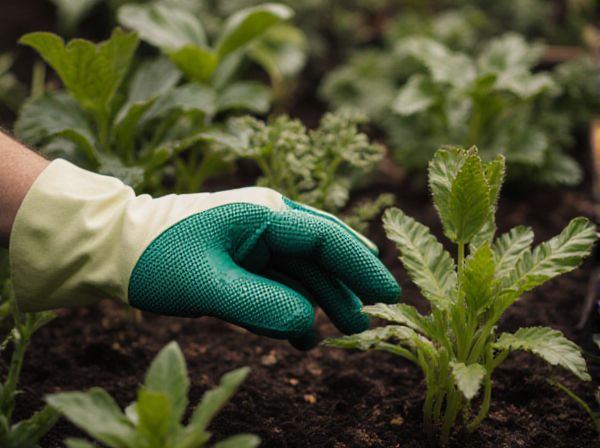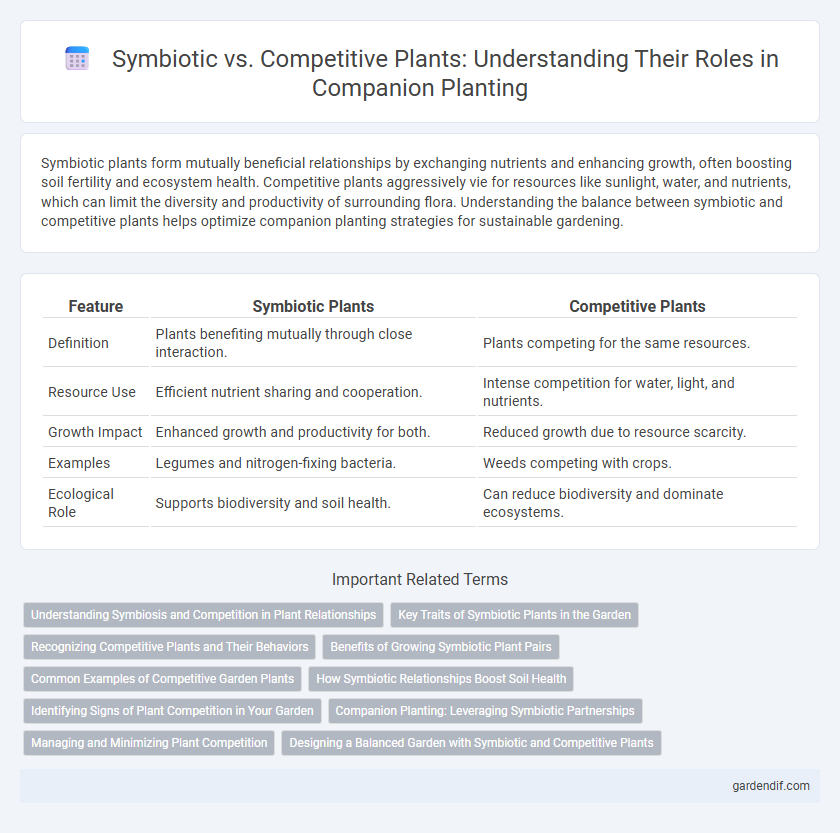
Symbiotic plants vs competitive plants Illustration
Symbiotic plants form mutually beneficial relationships by exchanging nutrients and enhancing growth, often boosting soil fertility and ecosystem health. Competitive plants aggressively vie for resources like sunlight, water, and nutrients, which can limit the diversity and productivity of surrounding flora. Understanding the balance between symbiotic and competitive plants helps optimize companion planting strategies for sustainable gardening.
Table of Comparison
| Feature | Symbiotic Plants | Competitive Plants |
|---|---|---|
| Definition | Plants benefiting mutually through close interaction. | Plants competing for the same resources. |
| Resource Use | Efficient nutrient sharing and cooperation. | Intense competition for water, light, and nutrients. |
| Growth Impact | Enhanced growth and productivity for both. | Reduced growth due to resource scarcity. |
| Examples | Legumes and nitrogen-fixing bacteria. | Weeds competing with crops. |
| Ecological Role | Supports biodiversity and soil health. | Can reduce biodiversity and dominate ecosystems. |
Understanding Symbiosis and Competition in Plant Relationships
Symbiotic plants engage in mutually beneficial interactions, such as nitrogen-fixing legumes partnering with Rhizobium bacteria to enhance soil fertility and promote growth. Competitive plants vie for limited resources like sunlight, water, and nutrients, often inhibiting the growth of neighboring species through allelopathy or resource monopolization. Understanding the balance between symbiosis and competition is essential for optimizing companion planting strategies that improve crop yield and ecosystem health.
Key Traits of Symbiotic Plants in the Garden
Symbiotic plants in the garden exhibit key traits such as nitrogen fixation, enhanced nutrient uptake, and mutualistic relationships with beneficial microbes. These plants, like legumes, improve soil fertility by converting atmospheric nitrogen into usable forms, promoting healthy growth of neighboring crops. Their ability to coexist harmoniously reduces the need for synthetic fertilizers and supports sustainable gardening practices.
Recognizing Competitive Plants and Their Behaviors
Competitive plants aggressively vie for resources like sunlight, water, and nutrients, often overshadowing neighboring species. Recognizing traits such as rapid growth, extensive root systems, and allelopathic properties helps identify plants that dominate their environment. These behaviors impact companion planting strategies by necessitating selection of species that can coexist or manage resource competition effectively.
Benefits of Growing Symbiotic Plant Pairs
Growing symbiotic plant pairs enhances nutrient uptake by allowing plants to share resources like nitrogen and phosphorus, improving soil fertility and reducing the need for chemical fertilizers. These partnerships also promote pest resistance and disease suppression, leading to healthier crops and higher yields. Integrating symbiotic plants into gardens supports sustainable agriculture through improved resource efficiency and ecosystem balance.
Common Examples of Competitive Garden Plants
Common examples of competitive garden plants include morning glories, bindweed, and Bermuda grass, known for their aggressive growth and tendency to overshadow neighboring plants. These species compete fiercely for nutrients, water, and sunlight, often hindering the growth of companion species. Their dominance in the garden ecosystem highlights the importance of careful plant selection to ensure balanced plant interactions and healthy garden development.
How Symbiotic Relationships Boost Soil Health
Symbiotic plants enhance soil health by forming mutualistic relationships with nitrogen-fixing bacteria, increasing nutrient availability and improving soil structure. These interactions promote organic matter decomposition and microbial diversity, facilitating nutrient cycling and soil fertility. In contrast to competitive plants that deplete resources, symbiotic plants create a balanced ecosystem that supports sustainable plant growth and resilience.
Identifying Signs of Plant Competition in Your Garden
Symbiotic plants share resources and support each other's growth, resulting in healthier soil and improved nutrient uptake, while competitive plants vie for the same nutrients, water, and sunlight, often leading to stunted growth or poor yields. Identifying signs of plant competition in your garden includes observing wilting, yellowing leaves, slow growth, or sparse foliage in certain plants, indicating they may be overshadowed or deprived by neighboring species. Monitoring plant spacing, root crowding, and uneven nutrient distribution helps gardeners optimize plant pairings and promote a balanced, productive garden ecosystem.
Companion Planting: Leveraging Symbiotic Partnerships
Companion planting harnesses the natural benefits of symbiotic plants, such as nitrogen-fixing legumes that enrich soil fertility for neighboring crops, promoting healthier growth and higher yields. This strategy contrasts with competitive plants that vie for the same nutrients, water, and space, often reducing overall productivity. Leveraging symbiotic partnerships in companion planting maximizes resource efficiency and supports sustainable agriculture by enhancing plant resilience and biodiversity.
Managing and Minimizing Plant Competition
Symbiotic plants form mutually beneficial relationships that enhance nutrient uptake and improve soil health, reducing competition for resources in companion planting. Competitive plants aggressively vie for sunlight, water, and nutrients, often requiring strategic spacing and selective pairing to minimize growth interference. Effective management techniques include crop rotation, intercropping with complementary species, and targeted pruning to optimize resource sharing and promote harmonious growth.
Designing a Balanced Garden with Symbiotic and Competitive Plants
Designing a balanced garden involves strategically combining symbiotic plants, such as legumes that fix nitrogen, with competitive plants that effectively utilize resources like light and water. Integrating species with complementary root structures and growth habits promotes healthy nutrient cycling and minimizes resource depletion. This balanced approach enhances plant resilience, maximizes yields, and supports sustainable garden ecosystems.
Symbiotic plants vs competitive plants Infographic

 gardendif.com
gardendif.com